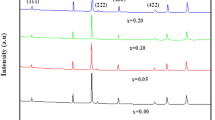Abstract
The aims were to characterize MoS2/CoFe2O4 nanocomposite and investigate its thermal therapy efficiency on cancerous (MCF-7) and normal (MCF-10A) human breast cells. Magnetic nanocomposites (MNCs) characterized by scanning/transmission electron microscopy (SEM/TEM), X-ray diffraction (XRD), Fourier transform infrared spectroscopy (FTIR) and vibrating sample magnetometer (VSM) techniques. TEM and SEM techniques showed MoS2/CoFe2O4 MNCs had an average size of 17±4 nm with almost spherical morphology. Magnetic properties of MNC measured by VSM, which resulted in specific loss power (SLP) of 766.61 W/g at 300 K. Cytotoxicity of MoS2/CoFe2O4 nanocomposites in MCF-7 and MCF-10A cell lines remained insignificant until 48 hours, which confirms its biocompatibility. Low concentration (200 ug/mL) of MoS2/CoFe2O4 was exposed to the low-frequency alternative magnetic field (f = 150 kHz, H = 31.16 mT) in a way that delivery of thermal ablation via magnetic fluid hyperthermia (MFH) occurred exclusively in cancerous (MCF-7) cells.
Similar content being viewed by others

Abbreviations
- K:
-
Kelvin temperature scale
- T:
-
Temperature or celsius temperature scale
- W:
-
(Watt) Effective work
- f :
-
Frequency (Hz)
- H:
-
Auxiliary magnetic field, electromagnetic amplitude
- C:
-
Concentration
- mT:
-
Mili Tesla
- emu/g:
-
(Mass) magnetization
- Oe:
-
Oersted, unit of the auxiliary magnetic field
References
I. C. H. Group et al., Radiotherapy with or without hyperthermia in the treatment of superficial localized breast cancer: results from five randomized controlled trials, International Journal of Radiation Oncology Biology Physics, 35(4) (1996) 731–744.
H. Nazari et al., Incorporation of spion — casein core — shells into silk — fibroin nanofibers for cardiac tissue engineering, Journal of Cellular Biochemistry, 121(4) (2020) 2981–2993.
Z. Zomordikhani et al., Analysis of nonlinear bioheat transfer equation in magnetic fluid hyperthermia, Journal of Mechanical Science and Technology, 34(9) (2020) 3911–3918.
S. Dutz and R. Hergt, Magnetic particle hyperthermia—a promising tumour therapy?, Nanotechnology, 25(45) (2014) 452001.
S. Hatamie et al., Heat transfer of pegylated cobalt ferrite nanofluids for magnetic fluid hyperthermia therapy: in vitro cellular study, Journal of Magnetism and Magnetic Materials, 462 (2018) 185–194.
S. Wang et al., Two-dimensional nanoparticles for the delivery of anticancer drugs and cancer therapy, Frontiers of Nanoscience, Elsevier, 16 (2020) 151–199.
R. Kurapati et al., Biomedical uses for 2D materials beyond graphene: current advances and challenges ahead, Advanced Materials, 28(29) (2016) 6052–6074.
M. Tamaddon et al., Involved micrornas in alternative polyadenylation intervene in breast cancer via regulation of cleavage factor “CFIm25”, Scientific Reports, 10(1) (2020) 1–11.
H. Jahangirian et al., A review of small molecules and drug delivery applications using gold and iron nanoparticles, International Journal of Nanomedicine, 14 (2019) 1633.
M. S. Alavijeh et al., Distribution of “molybdenum disulfide/cobalt ferrite” nanocomposite in animal model of breast cancer, following injection via differential infusion flow rates, Journal of Pharmaceutical Investigation (2020) 1–10.
G. Wang et al., Controlled synthesis of CoFe2O4/MoS2 nano-composites with excellent sedimentation stability for magnetorheological fluid, Journal of Industrial and Engineering Chemistry, 70 (2019) 439–446.
M. G. Naseri et al., Simple synthesis and characterization of cobalt ferrite nanoparticles by a thermal treatment method, Journal of Nanomaterials, 2010 (2010).
R. Singla et al., Toxicity concerns of therapeutic nanomaterials, Journal of Nanoscience and Nanotechnology, 19(4) (2019) 1889–1907.
S. Hatamie et al., Graphene/cobalt nanocarrier for hyperthermia therapy and mri diagnosis, Colloids and Surfaces B: Biointerfaces, 146 (2016) 271–279.
S. Klein et al., Enhanced in vitro biocompatibility and water dispersibility of magnetite and cobalt ferrite nanoparticles employed as ros formation enhancer in radiation cancer therapy, Small, 14(21) (2018) 1704111.
L. Cai et al., Vacancy-induced ferromagnetism of MoS2 nanosheets, Journal of the American Chemical Society, 137(7) (2015) 2622–2627.
E. Chagas et al., Thermal effect on magnetic parameters of high-coercivity cobalt ferrite, Journal of Applied Physics, 116(3) (2014) 033901.
Y. Bal, Nanomaterials for drug delivery: recent developments in spectroscopic characterization, Characterization and Biology of Nanomaterials for Drug Delivery, Elsevier (2019) 281–336.
Y. Zhou et al., Ultrasensitive NO2 gas sensing based on RGO/MoS2 nanocomposite film at low temperature, Sensors and Actuators B: Chemical, 251 (2017) 280–290.
S. Liu et al., Preparation of MoS2 nanofibers by electrospinning, Materials Letters, 73 (2012) 223–225.
I. Rad and G. H. Pollack, Cooling of pure water at room temperature by weak electric currents, The Journal of Physical Chemistry B, 122(31) (2018) 7711–7717.
X. Cui et al., Two-dimensional MoS2 modified using CoFe2O4 nanoparticles with enhanced microwave response in the X and Ku band, Inorganic Chemistry Frontiers, 6(2) (2019) 590–597.
Y. J. Kim et al., Quantitative analysis on cellular uptake of clustered ferrite magnetic nanoparticles, Electronic Materials Letters, 14(4) (2019) 471–480.
G. C. Van Rhoon et al., Cem43 °C thermal dose thresholds: a potential guide for magnetic resonance radiofrequency exposure levels?, European Radiology, 23(8) (2013) 2215–2227.
M. P. Calatayud et al., Cell damage produced by magnetic fluid hyperthermia on microglial BV2 cells, Scientific Reports, 7(1) (2017) 8627.
R. Hesari et al., Combination of low intensity electromagnetic field with chondrogenic agent induces chondrogenesis in mesenchymal stem cells with minimal hypertrophic side effects, Electromagnetic Biology and Medicine, 39(2) (2020) 154–165.
H. Nazari et al., Electrical stimulation induces differentiation of human cardiosphere- derived cells (HCDCS) to committed cardiomyocyte, Molecular and Cellular Biochemistry (2020).
Author information
Authors and Affiliations
Corresponding author
Additional information
Recommended by Editor Sehyun Shin
Adel Maghsoudpour received his M.Sc. and Ph.D. degrees in Mechanical Engineering from University of Tehran and SRBIAU, Tehran, Iran, respectively. His main research interest include hyperthermia and free vibrations.
Rights and permissions
About this article
Cite this article
Alavijeh, M.S., Maghsoudpour, A., Khayat, M. et al. Cobalt ferrite decoration of molybdenum disulfide nanosheets; development of a nanocomposite-mediated hyperthermia method. J Mech Sci Technol 35, 1319–1325 (2021). https://doi.org/10.1007/s12206-020-1242-9
Received:
Revised:
Accepted:
Published:
Issue Date:
DOI: https://doi.org/10.1007/s12206-020-1242-9



